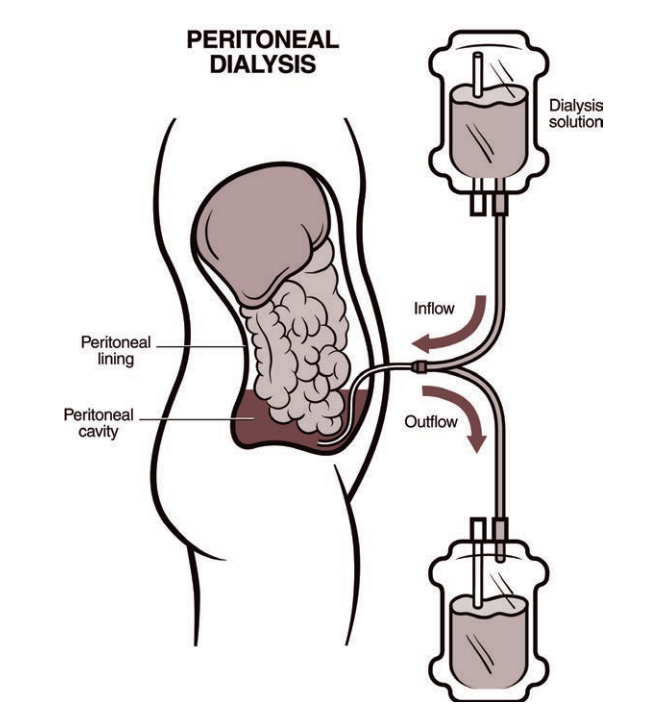The nurse is preparing a 50 mL dose of 50% Dextrose IV for a client with insulin shock. How should the nurse administer the medication?
Ask the pharmacist to add the Dextrose to a TPN solution.
Mix the Dextrose in a 50 mL piggyback for a total volume of 100 mL.
Push the undiluted Dextrose slowly through the currently infusing IV.
Dilute the Dextrose in one liter of 0.9% Normal Saline solution.
The Correct Answer is C
Choice C is correct because pushing the undiluted Dextrose slowly through the currently infusing IV is the best way to administer the medication for a client with insulin shock. Insulin shock is a condition in which the blood glucose level drops too low due to excess insulin or insufficient food intake. This can cause symptoms such as confusion, sweating, tremors, or loss of consciousness. The nurse should administer 50% Dextrose IV as a bolus injection to raise the blood glucose level quickly and prevent brain damage.
Choice A is incorrect because asking the pharmacist to add the Dextrose to a TPN solution is not appropriate for a client with insulin shock. TPN stands for total parenteral nutrition, which is a type of intravenous feeding that provides all the nutrients needed by the body. TPN solutions contain dextrose, amino acids, lipids, vitamins, minerals, and electrolytes in specific concentrations and ratios. Adding extra dextrose to a TPN solution can alter its composition and cause complications such as hyperglycemia or fluid overload.
Choice B is incorrect because mixing the Dextrose in a 50 mL piggyback for a total volume of 100 mL is not effective for a client with insulin shock. A piggyback is a type of intravenous infusion that delivers medication through a secondary tubing attached to the primary tubing of another solution. Mixing the Dextrose in a piggyback can dilute its concentration and reduce its potency. It can also delay its delivery and onset of action.
Choice D is incorrect because diluting the Dextrose in one liter of 0.9% Normal Saline solution is not safe for a client with insulin shock. Normal Saline is a type of intravenous fluid that contains sodium chloride in isotonic concentration. Diluting the Dextrose in one liter of Normal Saline can lower its concentration and increase its volume significantly. This can cause complications such as hypoglycemia or fluid overload.
Nursing Test Bank
Naxlex Comprehensive Predictor Exams
Related Questions
Correct Answer is ["4"]
Explanation
Step 1 is to convert the child’s weight from pounds to kilograms.
44 pounds ÷ 2.2 = 20 kilograms.
Result at each step = 20 kilograms.
Step 2 is to calculate the total dosage of furosemide in milligrams.
2 mg × 20 kg = 40 mg.
Result at each step = 40 mg.
Step 3 is to determine the volume of medication to administer in milliliters.
40 mg ÷ 10 mg/mL = 4 mL.
Result at each step = 4 mL.
The nurse should administer 4 mL.
Correct Answer is B
Explanation
Choice A reason: Support stockings may help with peripheral edema, but they are not the priority intervention for this client. The client's low serum albumin level indicates malnutrition and increased risk of infection and poor wound healing.
Choice C reason: Evaluating patency of the AV graft is not the priority intervention for this client because the client is receiving peritoneal dialysis, not hemodialysis. The AV graft may be used in the future if peritoneal dialysis fails, but it is not an immediate concern.
Choice D reason: Instructing the client to follow fluid restriction amounts is important for peritoneal dialysis patients, but it is not the priority intervention for this client. The client's low serum albumin level indicates that fluid restriction alone is not sufficient to manage fluid balance and prevent edema.

Whether you are a student looking to ace your exams or a practicing nurse seeking to enhance your expertise , our nursing education contents will empower you with the confidence and competence to make a difference in the lives of patients and become a respected leader in the healthcare field.
Visit Naxlex, invest in your future and unlock endless possibilities with our unparalleled nursing education contents today
Report Wrong Answer on the Current Question
Do you disagree with the answer? If yes, what is your expected answer? Explain.
Kindly be descriptive with the issue you are facing.
